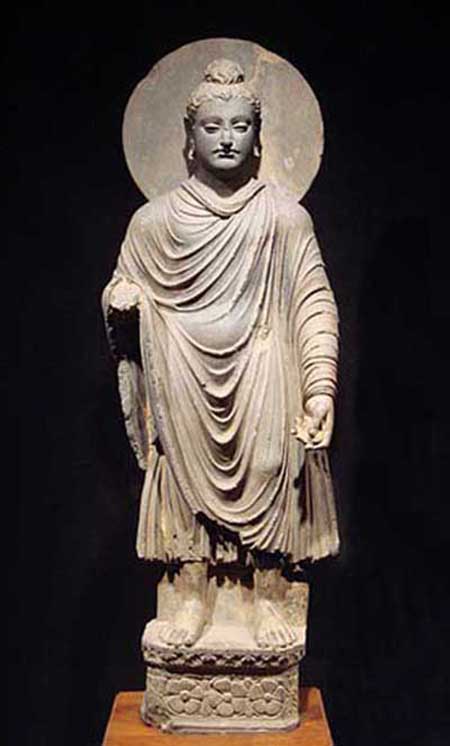
Standing Buddha. One of the earliest known
representations of the Buddha, 1st-2nd
century CE, Gandhara (modern Afghanistan).

Standing Buddha. One of the earliest known
representations of the Buddha, 1st-2nd
century CE, Gandhara (modern Afghanistan).
Buddhism is a religion and dharma that encompasses a variety of traditions, beliefs and spiritual practices largely based on original teachings attributed to the Buddha and resulting interpreted philosophies. Buddhism originated in Ancient India sometime between the 6th and 4th centuries BCE, from where it spread through much of Asia, whereafter it declined in India during the Middle Ages. Two major extant branches of Buddhism are generally recognized by scholars: Theravada and Mahayana (Sanskrit: "The Great Vehicle"). Buddhism is the world's fourth-largest religion, with over 520 million followers or over 7% of the global population, known as Buddhists.
Buddhist schools vary on the exact nature of the path to liberation, the importance and canonicity of various teachings and scriptures, and especially their respective practices. Practices of Buddhism include taking refuge in the Buddha, the Dharma and the Sangha, study of scriptures, observance of moral precepts, renunciation of craving and attachment, the practice of meditation (including calm and insight), the cultivation of wisdom, loving-kindness and compassion, the Mahayana practice of bodhicitta and the Vajrayana practices of generation stage and completion stage.
In Theravada the ultimate goal is the cessation of the kleshas and the attainment of the sublime state of Nirvana, achieved by practicing the Noble Eightfold Path (also known as the Middle Way), thus escaping what is seen as a cycle of suffering and rebirth. Theravada has a widespread following in Sri Lanka and Southeast Asia.
Mahayana, which includes the traditions of Pure Land, Zen, Nichiren Buddhism, Shingon and Tiantai (Tendai), is found throughout East Asia. Rather than Nirvana, Mahayana instead aspires to Buddhahood via the bodhisattva path, a state wherein one remains in the cycle of rebirth to help other beings reach awakening. Vajrayana, a body of teachings attributed to Indian siddhas, may be viewed as a third branch or merely a part of Mahayana. Tibetan Buddhism, which preserves the Vajrayana teachings of eighth century India, is practiced in regions surrounding the Himalayas, Mongolia and Kalmykia.Tibetan Buddhism aspires to Buddhahood or rainbow body. Read more

London Times - June 26, 1996
The British Library has discovered sensational manuscript fragments the potential significance of which for Buddhist scholars is comparable to that of the Dead Sea Scrolls for Christianity and Judaism.
The manuscripts, birchbark scrolls that looked like "badly rolled-up cigars" when first shown to the Library, are believed to be the earliest surviving Buddhist texts. "These will allow scholars to get nearer to what Buddha said than ever before," said Graham Shaw, deputy director of the Library's Oriental and India Office Collections.
They date from the end of the 1st century AD or the beginning of the 2nd century AD. Buddha, who inspired disciples to spread his teachings, died in 486 BC. "With these", said Mr. Shaw, "we're within 500 to 600 years of his death." Apart from bringing scholars closer to the original language of Buddha, this could corroborate the authenticity of teachings and sermons recounted in later texts.
The manuscripts include 60 fragments, ranging from Buddha's sermons to poems and treatises on the psychology of perception. The Library acquired them from a British dealer for a "five-figure sum", with help from an anonymous donor. Seen in a new light, their value is incalculable. Years of study lie ahead before the text can be deciphered, analyzed and compared with existing texts. The fragments include tales told on the banks of Lake Anavatapta at an assembly of the Buddha and his disciples.
Buddhists believe in reincarnation and each explains his deeds in a former life and how they influenced this one. Just getting a peek at the text proved difficult. Those involved had to uncurl the "cigars" whose fragility was a conservator's nightmare. Mr, Shaw said: "It is fiendishly brittle material. The first question was, 'will these ever unroll or will they simply crumble into many pieces?' "There have been reports in old excavations of things like this having been found and the moment they were touched literally crumbled to dust."
In just purchasing them, we were taking a risk. One didn't know whether they were salvable. We put them in a bell jar overnight and allowed them to be slowly moistened. Then one of our conservators used tweezers and began unrolling, and another applied more moisture, without saturating it. The exact origin of the scrolls is unknown beyond the fact that they were probably found in Afghanistan in earthenware jars. These, too, may be original pieces, but tests have yet to be conducted on them.
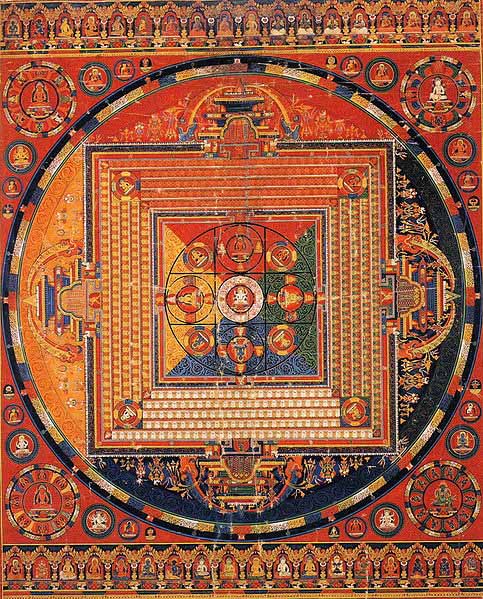
Thangka painting of Vajradhatu Mandala
Mandalas originated in India, but were mainly used in Tibetian Buddhism. Below are some quotes from various web sites (featured at the bottom of the page) regarding the origins of mandalas:
Tibetans became familiar with the mandala early in their introduction to Buddhist art and culture, a process begun with the first ruler of the historical period, Songtsen Gampo (srong-btsan sgam-po, d. 649).
Mandalas existed at early Buddhist centers in central Asia, e.g. Dunhuang and Khotan, both frequented by Tibetans during the eighth and ninth centuries.
Samye (bsam-yas), Tibet's first monastery founded ca. 779, was based on the architectural principles of a three-dimensional mandala, reportedly following the plan of Uddandapura monastery in eastern India.
Many such texts, crucial to the identification and interpretation of the mandala, were translated into Tibetan from Sanskrit and can be found in a portion of the Tibetan Buddhist canon known as the Tanjur (bstan-'gyur).
According to Buddhist history, the purpose, meanings, and techniques involved in the
spiritual art of sand mandala painting were taught by Shakyamuni, the historical Buddha in
the sixth century B.C. in India

Dorje is a Tibetan word.
Symbolically a dorje represents the 'thunderbolt of enlightenment,' that abrupt change in human consciousness which is recognised by all the great religions as a pivotal episode in the lives of mystics and saints.
The Bell and Dorje, or thunderbolt, are inseparable ritual objects in Tibetan Buddhism. They are always used in combination during religious ceremonies.
The Bell held in the left hand, representing the female aspect as wisdom; the Dorje, or male held in the right hand, aspect as method. Together, they represent union of wisdom and method, or the attainment of Enlightenment.
The transformative enlightenment experience is recounted in the various religions. In the Christian tradition, the conversion of Saul of Tarsus is a well known example and that of Muhammed on the mountain is fundamental to Moslem belief. For Buddhists, it is what occurred to the historical Buddha and to all those who experience kensho-satori, the dropping away of 'self'. The Tibetans call this "the Great Death" to distinguish it from that physical one which will be the experience of us all.
Dorje is a common given-name for men in people of Tibetan culture. Hence Phu Dorje, Ang Dorje (young Dorje) and Nima Dorje (Monday Dorje) or, more usually, Dorje.
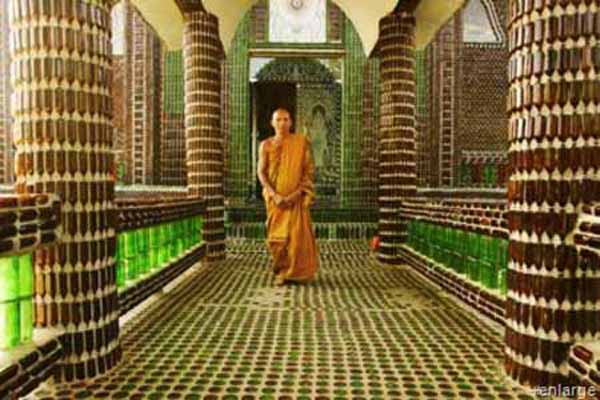
Thailand Temples
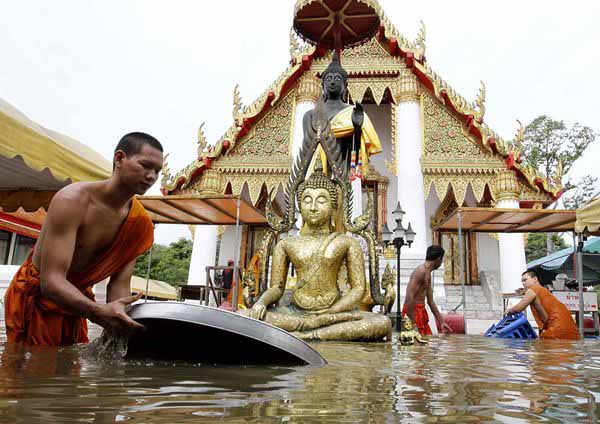
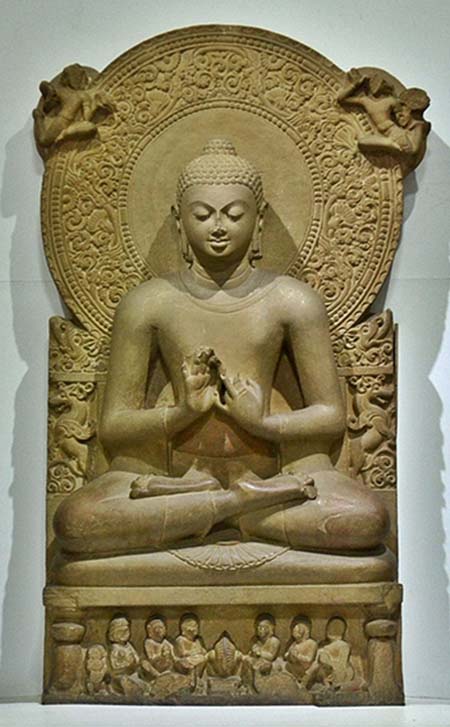
Buddha
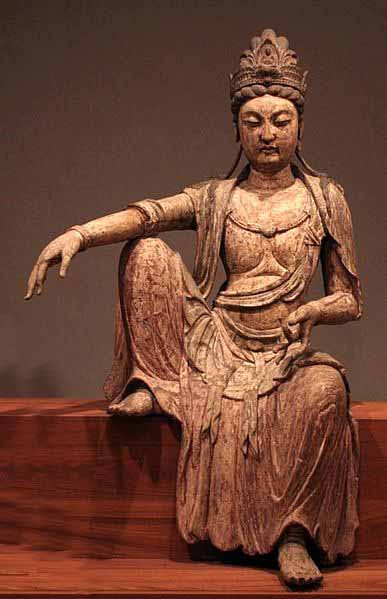
Kwan Yin